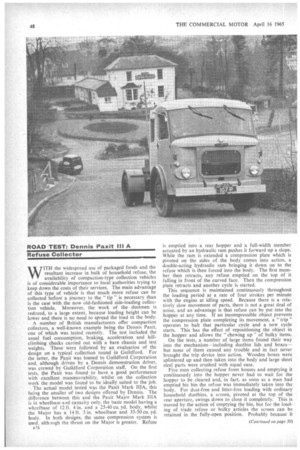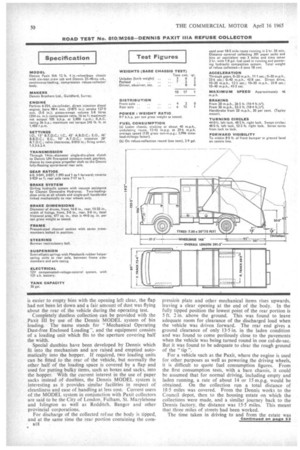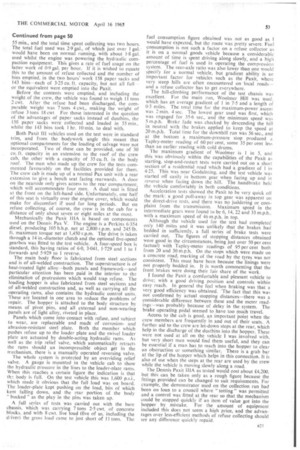W ITH the widespread use of packaged foods and the resultant
Page 50

Page 52

Page 55

If you've noticed an error in this article please click here to report it so we can fix it.
increase in bulk of household refuse, the availability of compaction-type collection vehicles is of considerable importance to local authorities trying to keep down the costs of their services. The main advantage of this type of vehicle is that much more refuse can be collected before a journey to the " tip " is necessary than is the case with the now old-fashioned side-loading collection vehicle. Moreover, the work of the dustmen is reduced, to a large extent, because loading height can be lower and there is no need to spread the load in the body.
A number of British manufacturers offer compaction collectors, a well-known example being the Dennis Paxit, one of which was tested recently. The test included the usual fuel consumption, braking, acceleration and hillclimbing checks carried out with a bare chassis and test weights. These were followed by an evaluation of the design on a typical collection round in Guildford. For the latter, the Paxit was loaned to Guildford Corporation and, although driven by a Dennis demonstration driver, was crewed by Guildford Corporation staff. On the first tests, the Paxit was found to have a good performance with excellent manceuvrability, whilst on the collection work the model was found to be ideally suited to the job.
The actual model tested was the Paxit Mark IIIA, this being the smaller of two designs offered by Dennis. The difference between this and the Paxit Major Mark IIIA is in wheelbase and capacity only, the basic model having a wheelbase of 12 ft. 4 in. and a 25-40 cu. yd. body, whilst the Major has a 14 ft. 5 in. wheelbase and 35-50 cu. yd. body. In both designs, the same compression system is used, although the thrust on the Major is greater. Refuse
e /6
is emptied into a rear hopper and a full-width member actuated by an hydraulic ram pushes it forward up a slope. While the ram is extended a compression plate which is pivoted on the sides of the body comes into action, a double-acting hydraulic ram bringing it down on to the refuse which is then forced into the body. The first member then retracts, any refuse emptied on the top of it falling in front of the curved face. Then the compression plate retracts and another cycle is started.
This sequence is maintained continuously throughout the loading period at a rate of four strokes per minute with the engine at idling speed. Because there is a relatively slow movement of parts, there is not a great deal of noise, and an advantage is that refuse can be put into the hopper at any time. If an incompressible object prevents the compression plate completing its movement, a " trip " operates to halt that particular cycle and a new cycle starts. This has the effect of repositioning the object in the hopper and allows the "chewing up" of bulky items.
On the tests, a number of large items found their way into the mechanism—including dustbin lids and boxes— but none of them caused any trouble and in fact never brought the trip device into action. Wooden boxes were splintered up and then taken into the body and large sheet steel parts were crushed with equal ease.
Five men collecting refuse from houses and emptying it continuously into the hopper never had to wait for the hopper to be cleared and, in fact, as soon as a man had emptied his bin the refuse was immediately taken into the body. For dust-free and litter-free loading with ordinary household dustbins. a screen, pivoted at the top of the rear aperture, swings down to close it completely. This is moved by the action of emptying the bin, but for the loading of trade refuse or bulky articles the screen can be retained in the fully-open position. Probably because it is easier to empty bins with the opening left clear, the flap had not been let down and a fair amount of dust was flying about the rear of the vehicle during the operating test.
Completely dustless collection can be provided with the Paxit III by use of the Dennis MODEL system of bin loading. The name stands for "Mechanical Operating Dust-free Enclosed Loading", and the equipment consists of a loading unit which fits to the aperture covering half the width.
Special dustbins have been developed by Dennis which fit into the mechanism and are raised and emptied automatically into the hopper. If required, two loading units can be fitted fo the rear of the vehicle, but normally the other half of the loading space is covered by a flap and used for putting bulky items, such as boxes and sacks, into the hopper. With the current interest in the use of paper sacks instead of dustbins, the Dennis MODEL system is interesting as it provides similar facilities in respect of cleanliness and ease of handling at less cost. Current users of the MODEL system in conjunction with Paxit collectors are said to be the City of London. Fulham, St. Pvfarylebone and Islington as well as Redditch. Bangor and other provincial corporations.
For discharge of the collected refuse the body is tipped, and at the same time the rear portion containing the corn818
pressiOrt plate and other mechanical items rises upwards, leaving a clear opening at the end of the body. In the fully tipped position the lowest point of the rear portion is 5 ft. 2 in. above the ground. This was found to leave adequate room for clearance of the discharged load when the vehicle was driven forward. The rear end gives a ground clearance of only 13-5 in. in the laden condition and was found to come perilously close to the pavements when the vehicle was being turned round in one cul-de-sac. But it was found to be adequate to clear the rough ground of the "tip ".
For a vehicle such as the Paxit, where the engine is used for other purposes as well as powering the driving wheels, it is difficult to quote fuel consumption figures. From the first consumption tests, with a bare chassis, it could be assumed that for normal driving, including empty and laden running, a rate of about 14 or 15 m.p.g. would be obtained. On the collection run a total distance of 18.5 miles was covered. From the Dennis works to the Council depot, then to the housing estate on which the collections were made, and a similar journey back to the Dennis factory, the distance was 15-5 miles. This meant that three miles of streets had been worked.
The time taken in driving to and from the estate was 55 min., and the total time spent collecting was two hours. The total fuel used was 2.9 gal., of which just over I gal.• would have been on normal running, with about 1-8 gal. used whilst the engine was powering the hydraulic compaction equipment. This gives a rate of fuel usage on the latter work of 0.9 gal. per hour. If it is wished to equate this to the amount of refuse collected and the number of bins emptied, in the two hours' work 158 paper sacks and 143 bins—each of 3.25 Cu. ft. capacity, but not all full— or the equivalent were emptied into the Paxit.
Before the contents were emptied, and including the weight of the crew, the vehicle was found to weigh 11 tons 2 cwt. After the refuse had been discharged, the comparable weight was 7 tons 4 cwt., making the weight of refuse 3 tons 18 cwt For those interested in the question of the advantages of paper sacks instead of dustbins, the 158 paper sacks were collected and loaded in 55 mia., whilst the 143 bins took 1 hr. 10 min. to deal with.
Both Paxit Ill vehicles used on the test were in standard trim, and from the bodywork angle this meant that optional compartments for the loading of salvage were not incorporated. Two of these can be provided, one of 30 Cu. ft. capacity in an extension to the roof of the crew cab, the other with a capacity of 35 Cu. ft. in the body roof. The men who made up the crew for the tests commented favourably on the facilities provided for them. The crew cab is made up of a normal Pax unit with a rear extension to give a bench seat facing rearwards. A door on the nearside only gives access to the rear compartment. which will accommodate four men. A dual seat is fitted at the front on the left-hand side. Unfortunately. one half of this seat is virtually over the engine cover, which would make for discomfort if used for long periods. But on refuse collecting, of course, the crew is in the cab for a distance of only about seven or eight miles at the most.
Mechanically the Paxit IIIA is based on components used on the Dennis Pax V. The engine is a Perkins 6-354 diesel, producing 105 b.h.p. net at 2,800 r.p.m. and 245 lb. ft. maximum torque net at 1,450 r.p.m. The drive is taken through a 14 in.-diameter clutch and the optional five-speed gearbox was fitted to the test vehicle. A four-speed box is standard, this having ratios of 6.0, 3-041, 1.729 and 1 to I forwards and 5.929 to 1 reverse.
The main body floor is fabricated from steel sections and is of all-welded construction. The superstructure is of heat-treated light alloy —both panels and framework—and particular attention has been paid in the interior to the elimination of protrusions which would trap refuse. The loading hopper is also fabricated from steel sections and of all-welded construction and, as well as carrying all the operating rams, also contains the hydraulic control units. These are located in one area to reduce the problems of repair. The hopper is attached to the body structure by means of pivot pins, and all external and non-wearing panels are of light alloy, riveted in place.
Panels which come into contact with refuse, and subject to wear, are replaceable and made of corrosionand abrasion-resistant steel plate. Both the member which pushes refuse up to the loader plate and the swivel loader plate are actuated by double-acting hydraulic rams. As well as the trip relief valve, which automatically retracts the rams should an incompressible object get in the mechanism, there is a manually operated reversing valve.
The whole system is protected by an overriding relief valve. A gauge is mounted in the vehicle cab to show the hydraulic pressure in the lines to the loader-plate rams. When this reaches a certain figure the indication is that th2. body is full. On the test vehicle this was 1.600 p.s.i., which made it obvious that the full load was on board. The loader-plate kept pushing on the load, bits of which kent falling down, and -the rear portion of the body " bucked " as the play in the pins was taken up.
A full series of tests was carried out with the bare chassis, which was carrying 7 tons 2-5 cwt. of concrete blocks, and with 8 cwt. live load (five of us, including the d..-iver) the gross load came to just short of 11 tons. The
fuel consumption figure obtained was not as good as I would have expected, but the route was pretty severe. Fuel consumption is not such a factor on a refuse collector as it is on a normal goods vehicle because a considerable amount of time is spent driving along slowly, and a high percentage of fuel is used in operating the compression system. The rear-axle ratio was also lower than one would specify for a normal vehicle, but gradient ability is an important factor for vehicles such as the Paxit, where very steep hills are often encountered on local roads— and a refuse collector has to get everywhere.
The hill-climbing performance of the test chassis was excellent. For the main run, Woolmer Hill was used. which has an average gradient of I in 7-5 and a length of 0.3 miles. The total time for the maximum-power ascent was 2 min. 4 sec. The lowest gear used was first, which was engaged for 35.6 sec., and the minimum speed was 5 m.p.h. Brake fade was checked by descending the hill in neutral with the brakes applied to keep the speed at 20 m.p.h. Total time for the downhill run was 56 sec., and at the bottom a maximum-pressure stop produced a Tapley-meter reading of 60 per cent, some 35 per cent less than an earlier reading with cold drums.
The maximum gradient of Woolmer is 1 in 5, and this was obviously within the capabilities of the Paxit as starting, stop-and-restart tests were carried out on a short section of a residential road which had gradient of 1 in 4-25. This was near Godalming, and the test vehicle was started off easily in bottom gear when facing up and in reverse when facing down the hill. The handbrake held the vehicle comfortably in both conditions.
Acceleration tests showed the Paxit to be very quick oft the mark: a good pull-away in top gear was apparent on the direct-drive tests, and there was no juddering or complaint from the transmission. Maximum speed in the intermediate gears were found to be 6, 14, 22 and 33 m.p.h., with a maximum speed of 46 m.p.h. in top. Although the vehicle used for the test had completed only 140 miles and it was unlikely that the brakes had bedded in sufficiently, a full series of brake tests were carried out. The figures of stopping distances obtained were good in the circumstances, being just over 50 per cent (actual) with Tapley-meter readings of 95 per cent both from 20 and 30 m.p.h. On the stops which were made on a concrete road, marking of the road by the tyres was not consistent, This must have been because the linings were not properly bedded in. It is worth commenting that the front brakes were doing their fair share of the work.
I found the Paxit a comfortable and pleasant vehicle to drive; with a good driving position and controls within easy reach. In general the feel when braking was that a very good efficiency was obtained. The fact that this was not confirmed by actual stopping distances—there was a considerable difference between these and the meter readings—was probably because of delay in the system. The brake operating pedal seemed to have too much travel.
Access to the cab is good, an important point when the crew members are frequently in and out of their seats. A further aid to the crew are let-down steps at the rear, which help in the discharge of the dustbins into the hopper. These were not used at all on the vehicle I was involved with, but very short men would find them useful, and they can be essential if a man has to reach into the hopper to clear an obstruction or something similar. There is a grab bar at the lip of the hopper which helps in this connection. It is also of use when the steps at the rear are used by the crew while the vehicle is moving slowly along a road.
The Dennis Paxit HIA as tested would cost about £4,200, but this can be taken only as a rough figure because the fittings provided can be changed to suit requirements. For example, the demonstrator used on the collection run had been on loan to a council where " totting " was permitted and a control was fitted at the rear so that the mechanism could be stopped quickly if an item of value got into the hopper by mistake. For the amount of equipment included this does not seem a high price, and the advantages over less-efficient methods of refuse collecting should see any difference quickly repaid.




















































































































